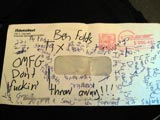A few months ago my home theater suffered a nearly-fatal blow: my receiver died. I was obligated to remove it and put in an old friend to hold down the fort until I could replace my fallen soldier. A couple of weeks ago I finally got a replacement, and started the process of planning, configuring, and upgrading my home theater. This weekend I put in the final piece of the puzzle, and can now say that I have a home theater to be proud of. And the best part is that I didn’t have to pay through the nose to get something I’m proud of. Until very recently, I worried I would have to build a whole new HTPC. Thankfully, a solution arose in the most unlikely of places.
With all of that work (some might even call it fun) out of the way, I can around to describing the thing, and hopefully sharing some tips so that others attempting something similar to what I did can get it done without quite as much hassle. This subject is kind of hard for me to write about, for two opposing reasons. The reason I am apt to write this all down is because I love technical things, and I especially love stereo (and home theater setup). However, I’m wary about writing about it because when I see others do so it often feels to me almost like bragging, as in, “look at how much neat stuff I have!” I realize that the fault probably lies with me and the way I perceive people talking about this stuff, but at the same time it makes me want to avoid that sort of thing, so I’ll try. I want to make this about the technology, not how much it costs. That’s why I’m focusing on the “without breaking the bank” part.
I’m going to divide this up into several articles, because I could write quite a lot about it. This first part will be about the solution I went with on my HTPC, and my search for a video player. I will also cover my remote control configuration and receiver setup later.
Part 1: Finding a Video Player
One of my chief goals was to find a way to play HD video without having to go too far out of my way. I knew this was likely to be a tough nut to crack. None of my computers are what you would call cutting-edge. I’m a web programmer, so I don’t really have to have a beefy CPU for compiling, and I’m not some knee-jerk gamer who dumps cash on the biggest, meanest graphics card. That means I’m never on the cutting edge of hardware: I wouldn’t utilize the bleeding edge anyway. At the same time, I realize that HD video is permeating many parts of our lives and it’s just going to become more prevalent, so I wanted to focus on future-proofing (or at least future-preparing) my setup.
My home theater is a modest Compaq box I got when I was in college and switched majors to Computer Science about five years ago. It has an AMD Athalon x64 processor, 2GB of RAM, and a decent video card I got a couple of years later (I think it’s an nVidia GeForce 7000 series card, and I know it has 128 MB RAM). I’ve got it hooked up to my receiver via a DVI-to-HDMI adapter and digital coaxial output. It can show 1080p (and that’s the way it runs), but I knew that it would take a miracle to get actual 1080p video running on it.
About a year and a half ago, I decided to use MediaPortal as the media library/playback app. I also looked at XBMC, but at the time it was too buggy to consider. There are yet other options, but MediaPortal is the one I settled on because of how configurable it is, and how suited it is to what I need (playback of video on Windows shares, and occasional music, too). I could have gone with a whole different Operating System, but settled on Windows XP as it is stable and lean compared to Vista. I considered Linux briefly, but decided that my hardware requirements would make getting it to work into a chore instead of a hobby. Things may have changed in the last eighteen months, but I’ve kind of settled upon Windows for now.
720p video worked right out the door via MediaPortal. I’m not 100% certain, but I’m confident that it wouldn’t play smoothly on this box without a little something called DVXA. DXVA is a Microsoft API that uses your graphics card to help decode demanding video (like H.264-encoded stuff, which is primarily what HD video uses these days). My confirmation of this is that the 720p video doesn’t run smoothly on this box in VLC, which as far as I know doesn’t use hardware acceleration at all.
1080p video flat out didn’t work. I figured it wouldn’t on this box. Betting on a long shot, I gave it a try anyway using both MediaPortal (which crashed) and Media Player Classic Home Cinema, which also uses DXVA but probably doesn’t have as much overhead as MediaPortal. No luck with either, which is exactly what I expected.
I decided to try out my laptop. It was marketed and sold as a ‘media center laptop.’ I got this one about two and a half years ago to replace an aging Dell Latitudes I’d inherited from my father. It came with Vista Home Premium (which I replaced with Business). It’s got a speedier CPU: a Core 2 Duo. It’s also got 4GB of RAM and an 8000-series GeForce. I figured this should be more than enough to play 1080p video.
Wrong! VLC couldn’t hack it. It looked like VLC didn’t even use use both cores while decompressing. I tried MPC HC and it sort of worked after I tweaked the settings. Some 1080p video, like animation, would play just fine. The beefiest files I threw at it worked, too. But other 1080p files which should have required less decoding muscle were stuttering and had terrible lip synch. In all other respects, the laptop would have been a golden solution: it had an HDMI output which carried both HD video and sound, and I had a free port on my receiver and a decent-sized cable. I finally managed to configure MPC HC to send the digital audio straight out over the HDMI instead of decoding it stereo, so I had 5.1 surround, too. But when I sat down to do a test run, it still had some problems. Video would stutter and lip synch would often drift, sometimes being correct and other times being just enough off to be frustrating.
At this point, I thought maybe my network was to blame. My server is downstairs in the basement. I had first tried a pair of Ethernet-over-power (also known as Powerlink) bridges, but I think my house’s wiring is too old and noisy to privde reliable throughput. It couldn’t even deliver reduced-size DVD rips from the server. I upgraded to a wireless bridge with 802.11n, and this was at least able to deliver a 4GB DVD rip in the time it took to watch it. I figured maybe my laptop was decoding video just fine, but not receiving content quickly enough. A quick copy of a 6.5 GB, hour-long 1080p video took about 43 minutes, which should have been enough to do it. But I tried watching the copied video direct from my hard drive, and it was still displaying the same behavior.
This is when things started to veer of into crazy land. I tried my wife’s PC, which is in the same room as the TV and has a slightly beefier processor and a much beefier graphics card than my laptop. It could play some video my laptop couldn’t, but bizarrely it couldn’t handle the video my laptop could.. At this point, I considered either building a new, extremely beefy HTPC or dropping some cash to run an HDMI cable the approximately 25 feet that would be necessary to connect my wife’s PC to the TV. Neither of these were ideal solutions, because I’d have to test a new 1080p video on both machines and screw around with display settings.
Strangely enough, my first-generation Intel iMac (just a Core Duo, not a Core 2) could play the same video my wife’s much newer PC could and could almost play the video that worked on my laptop — in VLC, no less. I had no idea why.
At this point I tried a couple of Linux LiveCDs on my laptop, figuring that Vista’s overhead may have been the problem, but ran into hardware configuration problems. This would also have required even more work than mentioned above. To watch 1080p video, I’d have to reboot with the LiveCD or install in onto my hard drive.
Is it clear I was close to madness at this point? Why could my 3.5 year-old iMac play most HD video just fine, while my newer laptop and my wife’s computer could only handle some of it? Why was MPC HC behaving so differently on different boxes when it was configured the same?
The solution came in the form of XBMC. I downloaded it on a whim, just to test it out. Not only could it play all my 1080p content at full resolution, but it could also do crazy things like fullscreen overlays and subtitles (just moving the mouse was enough to make playback jittery in MPC HC)! I even got it configured to output 5.1 digital audio without too much fiddling. So far, it’s played everything I’ve thrown at it.
The only problem I’ve seen is in some 1080 buffering issues. I think I know why. Today’s video codecs don’t encode information at the same bitrate all the time. A file has an average bitrate, which can roughly be calculated by dividing its size by its length. But the bitrate varies considerably. From 1:00:00 1:01:00, for example, it might play at 2 Mb / sec, but from 1:01:00 to 1:02:00, it might play at 3 Mb / sec or more. A smart codec squeezes as much extraneous data out of a scene as it can. This is easy in scenes with little motion. But a scene with a lot of action might have a much higher instantaneous bitrate. So even though my wireless N network can download the whole video in less time than is required to play it, it could be that certain parts have such a high bitrate that they can’t be played at my network’s transmission speed, while most of the rest of the video falls well below the average.
There’s not much I can do about this, aside from ‘pre-buffering’ HD video by copying it to the laptop first. I can’t lay cable in my house because it’s rented. My wife wouldn’t approve of stringing long ethernet cables down the stairs, either. Maybe there’s an option to increase XBMC’s video buffer. It definitely seems smarter than, for example, Amazon’s video-on-demand buffer or YouTube, but it’s hard to gauge these things. I might wind up getting a big hard drive exclusively for my HD content, attached to the network upstairs. Maybe I’ll look into a NAS solution.
So, here’s an overview of what I use the computers for:
- HTPC Box — SD video, DVD rips, HD video up to 720p. Also, I run various emulators off it, and play music from my server. This is all done via MediaPortal. Video is via HDMI out, audio is via digital coax up to 5.1 surround.
- Laptop — 1080p video played in XBMC. Video and audio via HDMI, up to 5.1 surround.
Not so complicated when it’s put that simply. The best part is that I didn’t have to build (and pay for) a new computer just to get full HD playback. The only drawback is that I can’t do anything else (like browse the web) on that laptop. I’ve still got the old Dell Latitude, so I could do it that way, but usually if I’m watching 1080p video, it’s got my full attention.
For Part II, I’ll go through what it took to get everything controlled by one remote.

 Full-Size (2048×1536)
Full-Size (2048×1536)


 Updates via
Updates via 